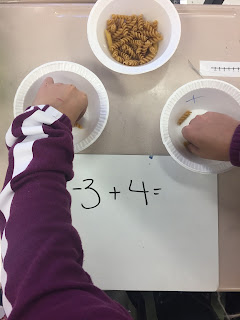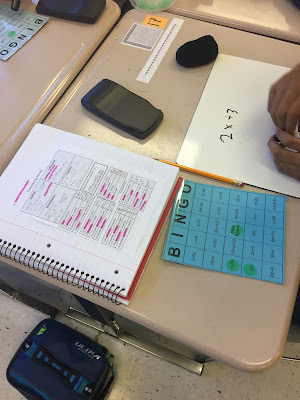I use this in all of my classes I have taught- Math 7, Algebra 1, Life Science...
Certainly, you could print something out that was nice and pretty for students to show work and write down their answers. I don't. I have students follow me (no speaking) and fold their notebook paper like I do. I demonstrate and they follow folding the paper so to create a certain number of boxes (ie. 8 boxes, 16, 32 (those are the easy ones)). We number each box and draw lines on all the creases- and now they have an answer sheet with work space (and every kids looks the same!!) [easy grading!].
Now to the meat and potatoes of [math] Power Hours. Yes- I got this after power hours that some may or may not done in college. No it has nothing to do with drinking. Obviously. I am sure there are more teachers in this world that do activities- just like this! I just happen to be sharing the idea! Let's be honest nothing is truly new at this point...So, If you know anything about power hours, the music changes each minute- tada! That is where this idea stemmed from!
I come up with review problems and attach music to each problem. When the music changes....so does the problem! My students love it! They can chat, work on problems, ask each other questions... and most importantly sing along!- but as soon as the song changes they know they have to move on.
I always create these on PowerPoint slides. I do it for several reasons but mainly because I can set timers, insert music and change slides very easily. I am sure there are several other programs that you could use.
Here are a few examples of what we did today in Algebra 1-- writing equations in Point Slope Form and converting them to slope intercept form.


A few questions regarding the activity that I have gotten in the past--
- Where do you get the music?
- How do you attach music?
- How fast do you go? Really one minute?
Where do I get my music?
- Yes, I purchase my music! Yes, I purchase music the kids enjoy and know! Not all the music on NOW! CD's/MP3s are "clean" but they are supposed to be. So I am definitely not vouching for them. I listen through the tracks a few times- but I find the NOW! music current and fairly cheap on Amazon. Remember I also teach upper middle school and not everything on the radio is always the best for younger kiddos.
- With Amazon you also have ten downloads on different devices when you purchase the MP3 version. I am sure there are plenty of other places to download and any music will suffice-- this is just what I use.
How do you attach music to PowerPoint?
- It is really not that hard! Have your music downloaded and your slides made with questions.
- Click Insert--> Click Audio/Media--> Audio from File--> Find and Select your song
- Then the important part: When you have the audio "clicked on" you must change it to start automatically!!! (not on click!). This allows the music to start as soon as you change the slide.
How fast do you go? Really one minute?
- I used to have them automatically change. However, honestly my classes work at different paces. Now, I no longer time them. I look around the room and when most kids are done working (timely!!!) I press the right arrow button on my keyboard or touch my ActiveBoard with my pen. It really depends on the problem, most are about 30 seconds to 90 seconds.
- AND NO!!!! I do not do this for a whole hour! Usually only about 8-16 problems, some that go quicker I may do more!
It has become an easy and wonderful review activity that my students really enjoy. It also allows me to help individual students (which is always great) and the rest of my students are able to work, chat, sing and enjoy their neighbors. We also love to bond over the music- because honestly-- aren't sing-a-longs the best?!
Enjoy!
What wonderful review activities are your favorites?






































